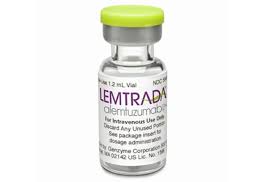Sanofi Genzyme Korea said Tuesday that it has presented a new study on Lemtrada, the company’s relapsing-remitting multiple sclerosis (RRMS) treatments, at the 34th European Committee for Research and Treatment in Multiple Sclerosis (ECTRIMS) held in Germany.

The company had confirmed that RRMS patients, who underwent initial Lemtrada two-course treatments, has sustained the therapeutic benefits of the treatment for more than eight years through the extension of two clinical trials -- CARE-MS I, CARE-MS II.
About percent of the CARE-MS I and 69 percent of the CARE-MS II patients participated in the eight-year follow-up study.
According to the two extended studies of CARE-MS I and CARE-MS II, which compared Lemtrada and human interferon-ßeta (IFN-β) directly, the annual recurrence rates for patients treated with Lemtrada for more than two years were 0.18 and 0.26, respectively. The results remained low during extended study periods with 0.14 and 0.18, respectively.
Also, 41 percent of the Lemtrada treatment group in CARE-MS I trial and 47 percent of the Lemtrada treatment group in the CARE-MS II clinical trial improved disability, and 71 and 64 percent of those patients showed no progression of the impairment during the eight years.
From year three to year eight, the annual brain volume loss rates of the Lemtrada treatment group were less than 0.22 and 0.19 percent, respectively, and the brain volume loss rates were lower than those observed during the previous clinical trial period. The company also confirmed no evidence of MRI- active lesions in most patients.
Most of the adverse events that occurred during the extended study period decreased over time compared to the time when the company conducted the previous two clinical trials.
The frequency of thyroid-related adverse events was the most common in patients in their third year of treatment, but declined after that, the company said.
About 66 and 44 percent of the CARE-MS I patients and the CARE-MS II patients did not require any additional treatment during the eight-year extended study after their initial treatment of 12 months.

